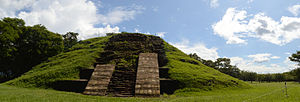Cihuatán
The founding of Cihuatán may have been a by-product of the disruption caused by the Classic Maya collapse and corresponding shift in trade routes.[6] Although the ethnic identity of the site elite is unknown, the architectural style of the structures outside of the ceremonial core of the city is recognisably Maya.Spear points were frequent finds in the burnt layers and human remains were found trapped in drains in the acropolis that dated to the time of the city's destruction.Excavations included a cluster of residential buildings that had been hastily abandoned due to fire, resulting in many of the household goods being preserved when the walls collapsed.[2] The Western Ceremonial Centre includes a large pyramid, a number of west-facing platforms that originally supported superstructures, and two -shaped Mesoamerican ballcourts.This group of buildings was abandoned due to fire, and many household objects were recovered in situ, including large food storage jars, cooking pots, and decorated ceramics.


Cihuatlánpre-ColumbianEl SalvadorMesoamericanMesoamerican chronologyMaya civilizationPeopleSocietyLanguagesWritingReligionMythologySacrificeCitiesArchitectureAstronomyCalendarStelaeTextilesMedicineCuisineWarfareHistoryPreclassic MayaClassic Maya collapseSpanish conquest of the MayaYucatánChiapasGuatemalaPeténAguilaresSan SalvadorHondurastrade routesTlalocXipe TotecGulf coastVeracruzpyramidMesoamerican ballcourtsRadiocarbon datingobsidian toolscottonMaya sitesBelizeActun Tunichil MuknalAltun HaBaking PotBarton Creek CaveCahal PechCaracolCerrosChaa CreekCuelloEl PilarKaʼKabishKʼaxobLa MilpaLamanaiLouisvilleLower DoverLubaantunMarco GonzalezMinanhaNim Li PunitNohmulNohoch CheʼenPacbitunPusilhaSan EstevanSanta RitaUxbenkaXnahebXunantunichAguatecaAltar de SacrificiosArroyo de PiedraBalbertaBejucalCancuénCerro QuiacChitinamitChocoláChutixtioxCotzumalhuapaDos PilasEl BaúlEl ChalEl MiradorEl PerúEl PorvenirEl TemblorEl TintalEl ZotzGuaytánHolmulHoltunIximcheIxtontonIxtutzKaminaljuyuKʼatepanLa AmeliaLa BlancaLa CoronaLa JoyancaLa MuertaMachaquilaMixco ViejoMontanaMotul de San JoséNaachtunNaranjoPajaralPiedras NegrasPunta de ChiminoQuiriguáQʼumarkajRío AzulSan BartoloSan ClementeSeibalTakalik AbajTamarinditoTayasalTopoxte